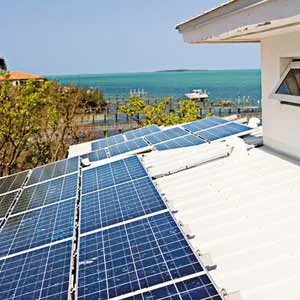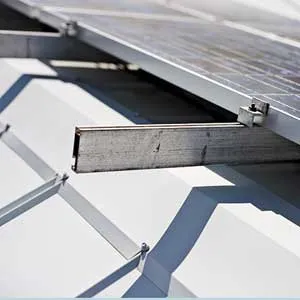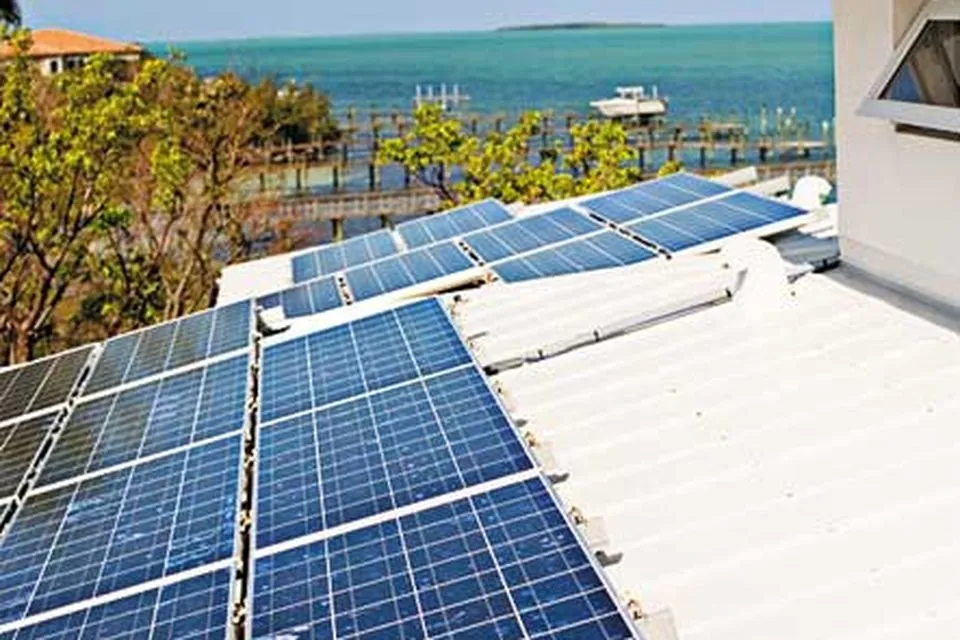
The biggest investment Key Largo, Florida, homeowners John Hammerstrom and Diane Marshall made toward energy efficiency in their eco-friendly home is the 2.8-kilowatt Kyocera solar panel system that adorns their rooftop. The panels, packed with photovoltaic cells, convert sunshine into the electrical current that provides half their household’s power needs. The couple’s electric bills typically run an affordable $50 per month in the summer, when the AC is kicking, and a measly $15 when it’s not.
If you’re thinking of following John and Diane’s example, there are a few things to consider, including the kind of equipment you’ll need. General guidelines call for 1 kilowatt, or 1,000 watts, per 1,000 square feet of house area, but you should work with your contractor to determine the right size for your home. Along with the panels, you’ll also need a device called an inverter to convert the sun’s DC voltage into usable AC power. Depending on where you live, such a system could cost anywhere from $15,000 to $35,000 installed.
But—and this is a big but—that cost can be dramatically reduced if your local government or utility company offers tax breaks, rebates, discounts, or grants for solar products. For example, Texas’s Austin Energy has a rebate program that reimburses customers $4.50 per watt, which ends up covering between 45 and 75 percent of the cost of solar panel installation. And Arizona offers a program that lets homeowners install solar energy devices without any increase to their property taxes.
Going solar doesn’t mean cutting ties to your local supply grid. As long as your utility company offers what’s known as “net metering,” you can plug your solar system into existing power lines, which kick back into service come sundown and on rainy days. If you generate more power when the sun is shining than you actually need, many states let you sell unused watts back to the local utility for a credit, making your electric meter effectively spin backward.
If there aren’t any incentives available in your area, don’t lose hope. When John and Diane’s panels were installed, their local utility had yet to offer net metering, so the couple put together their very own presentation for the utility’s board of directors and ultimately convinced them to adopt a net metering policy. They also received a $4-per-watt rebate from the Florida Solar Energy Center, which shaved $11,000 off the cost of the $25,000 system. Taking local electrical rates into account, John estimates he and Diane will recoup the cost of their investment in 12 to 15 years, though payback periods vary depending on local rates, incentives, and rebates.
One thing’s for sure: when it comes time to move, solar panels will add to a home’s resale value, no matter where you live. In fact, according to the U.S. Department of Housing and Urban Development, home values rise an average of $20 for every $1 reduction in annual utility bills.

The Right Climate for Solar
While it makes good sense to install solar panels in a place known as the Sunshine State, you don’t have to live in an ultraviolet stronghold to enjoy the benefits of renewable energy. Fact is, the affordability of installing panels depends more on local utility rates and incentives than on the amount of sunlight you get. For example, a standard 2-kilowatt system in New Mexico produces 25 percent more electricity than the same system in Massachusetts. But the energy savings are greater in the Bay State, since electricity rates are so much higher there.
And if you don’t like the idea of huge panels on your roof, you can also buy “building-integrated photovoltaics,” or BIPVs, which seamlessly integrate solar cells into slate, metal, fiber-cement, even asphalt roofing. The shingles get installed over new or existing roof sheathing, then an electrician or trained roofer wires the units together and ties them into your home’s electrical system.
Free Hot Water
If solar panels are more of a commitment than you’re willing or able to make, consider harnessing the sun’s power to heat your water. John and Diane’s ProgressivTube passive solar water heater is a self-contained system with a solar collector panel and an integrated 40-gallon storage tank. You can also get solar systems that act as preheaters for conventional or tankless water heaters. A typical passive solar water-heater setup costs $4,000 to $6,000, though tax incentives and rebates might be available to offset the price. And thanks to the energy savings, you’ll recoup your investment in as little as five years. How’s that for keeping on the sunny side of life?

